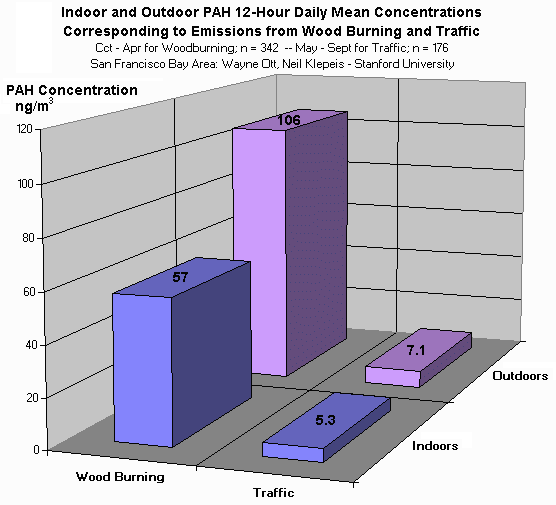Physicochemical characterization of combustion particles from vehicle exhaust and residential wood smoke. Anette Kocbach1, Yanjun Li2, Karl E Yttri3, Flemming R Cassee4,
Per E Schwarze1 and Ellen Namork*1
Address: 1Division of Environmental Medicine, Norwegian Institute of Public Health, P.O. Box 4404, N-0403 Oslo, Norway,Particle and Fibre Toxicology 2006, 3:1 doi:10.1186/1743-8977-3-1 Received: 27 May 2005 Accepted: 03 January 2006
This article is available from: http://www.particleandfibretoxicology.com/content/3/1/1
"The total Polycyclic Aromatic Hydrocarbon (PAH) content was higher for combustion particles from wood smoke as compared to vehicle exhaust, whereas no source difference was found for the ratio of organic to total carbon."
ABSTRACT : BACKGROUND : Exposure to ambient particulate matter has been associated with a number of adverse health effects. Particle characteristics such as size, surface area and chemistry seem to influence the negative effects of particles. In this study, combustion particles from vehicle exhaust and wood smoke, currently used in biological experiments, were analysed with respect to microstructure and chemistry.
METHODS : Vehicle exhaust particles were collected in a road tunnel during two seasons, with and without use of studded tires, whereas wood smoke was collected from a stove with single-stage combustion. Additionally, a reference diesel sample (SRM 2975) was analysed. The samples were characterized using transmission electron microscopy techniques (TEM/HRTEM, EELS and SAED). Furthermore, the elemental and organic carbon fractions were quantified using thermal optical transmission analysis and the content of selected PAHs was determined by gas chromatography-mass spectrometry. RESULTS : Carbon aggregates, consisting of tens to thousands of spherical primary particles, were the only combustion particles identified in all samples using TEM. The tunnel samples also contained mineral particles originating from road abrasion. The geometric diameters of primary carbon particles from vehicle exhaust were found to be significantly smaller (24 +/- 6 nm) than for wood smoke (31 +/- 7 nm). Furthermore, HRTEM showed that primary particles from both sources exhibited a turbostratic microstructure, consisting of concentric carbon layers surrounding several nuclei in vehicle exhaust or a single nucleus in wood smoke. However, no differences were detected in the graphitic character of primary particles from the two sources using SAED and EELS. The total PAH content was higher for combustion particles from wood smoke as compared to vehicle exhaust, whereas no source difference was found for the ratio of organic to total carbon.
CONCLUSION : Combustion particles from vehicle exhaust and residential wood smoke differ in primary particle diameter, microstructure, and PAH content. Furthermore, the analysed samples seem suitable for assessing the influence of physicochemical characteristics of particles on biological responses.
Stanford University neighborhood measurements of Polycyclic Aromatic Hydrocarbon (PAH).
Polycyclic Aromatic Hydrocarbon Exposure from Wood Burning And Traffic

Carcinogens (mainly PAH) were measured from wood smoke at eleven locations in the Bay Area. Here is a look at one of these locations in a residential area of Redwood City, from December to March.
